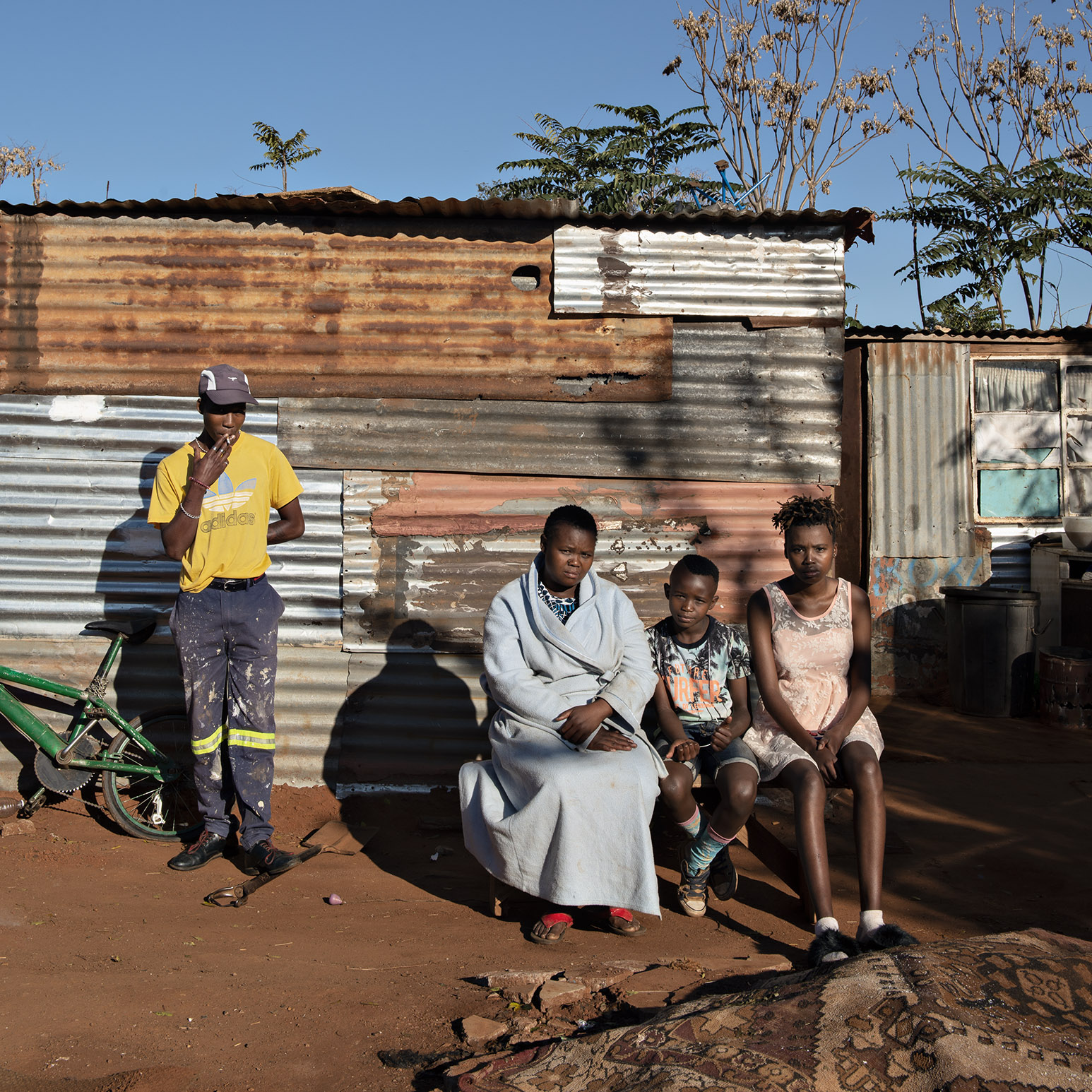
Snapshot is a weekly series that zooms in on a single photograph to explore the context of an image, the conditions it is created within and its wider cultural impact.
Lebohang Raethole, Boitumelo Mathibu and Her Kids, like all the works in Jabulani Dhlamini’s The Everyday Waiting series, is a diptych of two squares, in which the left is a photographic portrait, and the right is a low-formatted white text, quoted from the subject, on a black background. The photographs were all taken in Soweto, South Africa, during the recent Covid-19 lockdown.
It is Mathibu, one of the subjects in this image, whose words are presented alongside it. “No work no pay you know” is spoken with the knowledge that capitalism’s hold on her labour far exceeds (indeed, bulldozes) her and her kids’ right to survival in a time of global crisis. It is only through her ongoing physical labour (along, of course, with unpaid labour for the family) that their collective existence in poverty is possible.
“Mathibu’s description of her own experience of this socioeconomic reality during covid-19 is as horrific as it is historically unvaried”
Thus live the greatest proportion of South Africa; a population comprising a majority of poor Black people (“Black” here constituting racialised people in the country) people who, through white supremacist rule—under both British colonialism and Afrikaner apartheid nationalism—have long been designated as a fungible labour pool to sustain the growth of (white) profit. Mathibu’s description of her own experience of this socioeconomic reality during covid-19 is thus as horrific as it is historically unvaried.
In order to effectively analyse this photographic series, it is necessary to note both the socioeconomic narrative that exists within the frames of each image, and how the project, more broadly, is framed in the context of an exhibition. The series was recently shown at Goodman Gallery in London. It would seem that the display of portraits of historically disenfranchised, and in many cases, hungry subjects, in the very heart of the guilty empire, is a rather sinister intervention, only sensibly readable as an elaboration on the wealth disparity that the project itself describes. But perhaps the artist’s invisible underneath-work, involving portioning from his own sales percentage to a charity feeding kids in Phiri, Soweto, is the more crucial praxis at play? Perhaps the inevitable violence that often underscores the consumption of portraits of the “other’s” suffering, is simply the costly performative feature that sustains the urgent and hidden work of being in touch, being reciprocal, and keeping each other fed in the immediate moment?
In the highlighted photograph, four figures are contained in the frame, and the background is horizontally divided into a blue sky, the walls of corrugated-iron shacks, and a dry earth ground. The mother and children sit side-by-side in front of the wall, Mathibu’s feet squared down neatly, the small child’s crossed and pushed back beneath the bench, and the older-looking child’s stretched out in front, on the end of long legs which have the look of a recent growth spurt. All three directly engage the camera, the mother’s slight squint and the harsh shadow revealing the presence of the unfiltered Johannesburg winter sun.
“The urgent expressions of hunger, lack of resources and uncertain employment issued by Dhlamini’s subjects are jarring additions to a London white cube”
Another figure, Raethole, stands smoking to the left of the three, arm tucked behind his back, and eyes covered in shadow under a cap: the only pair of eyes not seeming to meet the camera directly. This figure’s yellow t-shirt is the single disruption to an otherwise consistent palette, where pink, turquoise, blues, browns and greys constitute the accents and background of the photograph, in clothing and tiling, the sky’s ombre, and the foregrounded dusty earth. Is Raethole, in paint-stained work pants, also part of the family, perhaps still labouring and earning through the lockdown? Such social details remain unknown.
But I get the feeling that these kinds of speculative attempts to pull stories from the photos may overburden Dhlamini’s project, whose accompanying quotations situate the focus less in the nuances of the sitters’ individual lives, and more precisely on the various systemic experiences of poor Black people living in South African townships. This is not to say that the project is not a personal one. Rather, in the spirit of the documentary, Mathibu’s personal, individual story comes to highlight the ongoing presence of millions of similar narratives.
The urgent expressions of hunger, lack of resources and uncertain employment issued by Dhlamini’s subjects are jarring additions to a London white cube, portraits and stories filling an all-too-familiar role on one end of the ethnographic gaze. To conclude the everyday waiting, when exhibited in this context, as primarily anything other than a series of documents telling of people in desperately precarious conditions, is to propose that the fact of their lives’ photographic capture should be prioritised above their actual lives.
“In the spirit of the documentary, Mathibu’s personal, individual story comes to highlight the ongoing presence of millions of similar narratives”
But it is the extended frame, the context of display, that sets up the varying relations between the images’ aesthetic and systemic compositions. In Mathibu’s own home, say, a classmate of her smaller kid may study the family album and comment excitedly, deeply impressed at his friend’s casually cool sock-shirt combo, the t-shirt’s tropical sky of peaches and pale blues, re-finding themselves closer to the ground, in socks wrapping up the folded feet. Ironically, I’m not sure that the art gallery, fraught with much looking and little being, is sufficiently human for such unguarded aesthetic conversation.
Visit the Thol’ulwazi community development Organization page on Facebook, where you can learn more about and donate to the organisation, which assists children in Phiri, Soweto with homework and other activities, and helps to provide meals to their community during the Covid-19 crisis.





